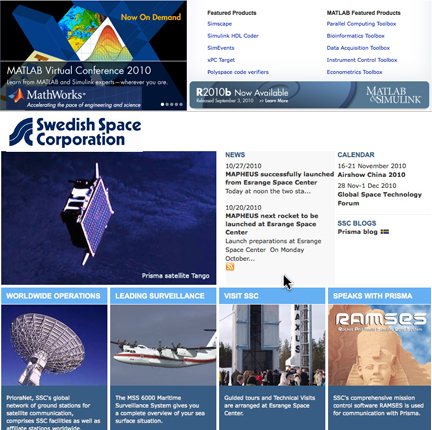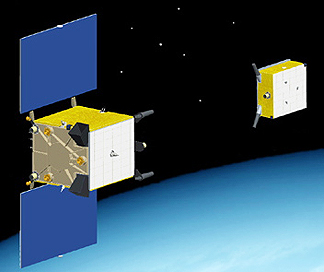MathWorks + Swedish Space Corp... Time Is Of The Essence (Satellites)
[SatNews] MathWorks has announced that Swedish Space Corporation (SSC) reduced, by 50 percent, the development time of its Prisma project, which tests and validates guidance, navigation, and control (GNC) strategies for advanced autonomous formation flying.

MathWorks homepage link...
SSC adopted
Model-Based Design with
MATLAB and Simulink to help model and simulate the GNC system, perform real-time closed-loop simulations, and generate production flight code. The
Prisma project uses two satellites,
Mango and
Tango, to demonstrate autonomous formation flying and autonomous rendezvous and proximity operations. SSC engineers needed new GNC algorithms to take advantage of the advanced sensors and propulsion systems of the satellites. They used
MATLAB,
Simulink, and
Stateflow to develop GNC algorithms, run and verify system-level closed-loop simulations in real time, and generate flight code for both satellites. To rehearse actual mission flight operations and verify flight command sequences, SSC ran simulations against the plant model on
xPC Target. The team also used MATLAB Compiler to build standalone applications for displaying and analyzing satellite flight data.
 Artistic rendition of Mango + Tango
Artistic rendition of Mango + Tango
Model-Based Design helped SSC clearly specify requirements and improve communications with its counterparts at the French and German space agencies and the
Technical University of Denmark. Model-Based Design also enabled the teams to identify and address design errors early in the development process. Using MathWorks tools throughout the organization helped eliminate data reentry and conversion between models and tools, and introduced additional time savings through reuse of 70 percent of the attitude control models developed for SSC’s
SMART-1 satellite, a
European Space Agency project. SSC engineers are further streamlining project efficiency by reusing Prisma models for yet a third project, a general-purpose geostationary satellite platform called
Small GEO.
Topical Tags :
Regional Tags :



